#asakura yoshikage
Explore tagged Tumblr posts
Text
Were the infamous skulls actually “skulls” or “heads”?
Some time ago, I was browsing the Unification/Azuchi-Momoyama volume of Kadokawa’s educational manga series on Japanese history. In a rather unique move, the scene of the presentation of Azai and Asakura’s heads depicted the whole heads gilded in gold instead of the usual skulls.
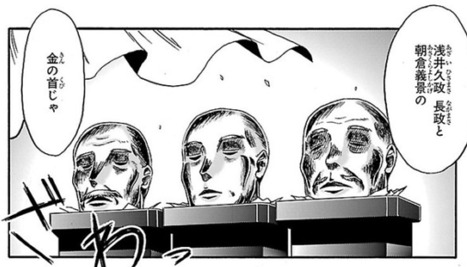
Indeed, the Shinchoukouki describes the heads as 首 kubi, which is the term used to usually mean heads. The description of the skull had come from the Azai Sandaiki, which mentioned that the heads had been “stripped of the flesh” before the lacquering.
The Azai Sandaiki was considered not entirely reliable, and the Japanese encyclopaedia labels it as more of a book of fables and folklore rather than a certified historical account. It makes sense that whoever worked on this manga then thought that maybe the heads are just heads based on the Shinchoukouki.
However, just because the Shinchoukouki doesn’t say “skulls”, doesn’t mean that they aren’t skulls. There are various words for “skull” (髑髏, 曝頭, 曝首, etc), but they’re not necessarily daily vocabulary that people would normally use at the time.
So, if the Azai Sandaiki is not wholly reliable and the Shinchoukouki wasn’t clear, were they actually skulls or heads, though?
I personally believe that the answer is “skulls”.
Here is why I believe that it makes more sense for the heads to be cleaned down to skulls before lacquering and gold leafing them:
The Azai father and son and Asakura Yoshikage were killed around September-October of 1573. After which, the heads were put in public display in Kyoto, where they were probably exposed to the weather and perhaps animals or insects.
Asakura Shikibu no Daibu brought Yoshikage’s head to the Ryūmonji in Fuchū [...] Nobunaga entrusted Yoshikage’s head to Hasegawa Sōnin, who brought it to Kyoto, where it was put on exhibition. (The Chronicle of Lord Nobunaga, page 198)
Nobunaga sent the heads of the Azai, father and son, up to Kyoto, where they were put on display at a prison gate [...] (The Chronicle of Lord Nobunaga, page 199)
This narration is corroborated by the existence of a letter Nobutada had sent, describing that Asakura’s head was being delivered to Kyoto for presentation (the letter was sent before the Oda army defeated the Azai).
While there’s no description of how long were they put on display for, it’s quite likely that they were going to be there for quite a while. These head displays were meant to serve as a proclamation of achievement and/or warning, after all.
By the time of the 1574 presentation, the heads had probably already deteriorated, and shall we say it’s not going to be a pretty sight?
It has been argued that what Nobunaga did was a form of the head presentation ceremonies typically done with enemy heads post-battle. This ceremony highly values aesthetics, and it’s demanded for fresh heads to be washed, perfumed, and even decorated with makeup.
Even supposing it actually isn’t a formal “head presentation”, the three heads were being displayed in a banquet. Skulls are going to be much more presentable than deteriorated heads (surely we all know zombies look horrible), and so I consider it to be the more likely option.
Not to mention that there is also the additional possibility of the heads wearing down to the bones naturally, precisely because of having been exposed to the elements. Perhaps, then, when the Oda vassals retrieved them from their “display” in Kyoto, they were already turned into skulls.
#japanese history#samurai#sengoku#Sengoku Era#Sengoku period#oda nobunaga#Azai Nagamasa#Azai Hisamasa#Asakura Yoshikage#azai sandaiki#shinchoukouki
7 notes
·
View notes
Text
Hello there Asakura Yoshikage fans.

0 notes
Text

Battle of Anegawa
#ancient japan#sengoku jidai#oda clan#tokugawa clan#azai clan#asakura clan#nobunaga oda#ieyasu tokugawa#nagamasa azai#yoshikage asakura
0 notes
Text
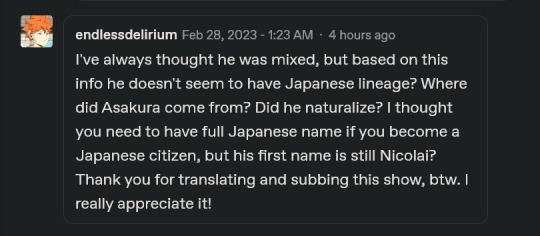
@endlessdelirium allow me to answer this question more fully lol.
So, it's possible he naturalized. But in his flashback episode he was introducing himself as "Nicolai Asakura" to his classmates so maybe that was always his name? Did he just change it as he told the story? I'm not sure lol. I'm really not sure why he has a Japanese surname.
The only requirement for a "Japanese name" when you naturalize is that it's in Japanese characters, so his name being ニコライ in katakana would be allowed. He wouldn't have needed to change his surname to be "Japanese" either.
But the big thing, and probably the reason they used it, is that everyone at Manpuku are named after famous people from the sengoku era.
Sanada Kentarou = Sanada Yukimura
Ishida Naoki = Ishida Mitsunari
Asai Haru = Asai Nagamasa
Kakizaki Makoto = Kakizaki Kageie
Yamanaka Daisuke = Yamanaka Yukimori
Imagawa Tsuyoshi = Imagawa Yoshimoto
Nicolai Asakura = Asakura Yoshikage
Manda Fukuko = Mitsuta Yasutoshi (no English page), Mitsuta has the same kanji (満田) but a different reading.
Ukita Ren = Ukita Hideie
There might be something going on with the Twilight characters as well but it was less easy for me to figure out where their names came from.
13 notes
·
View notes
Text
posting these here to store them

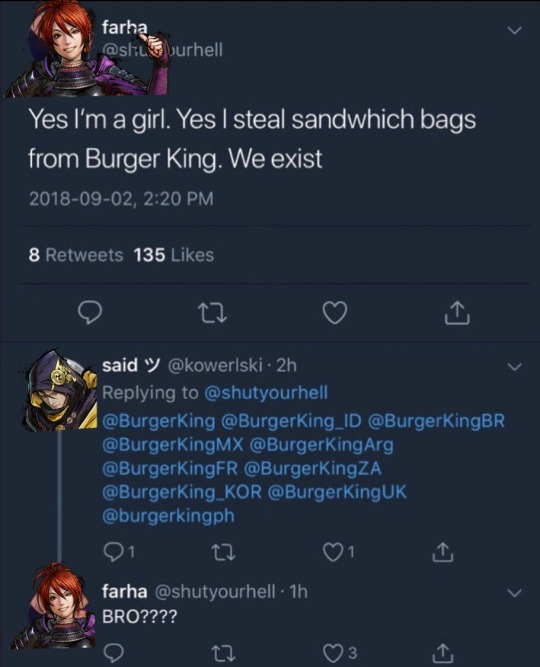

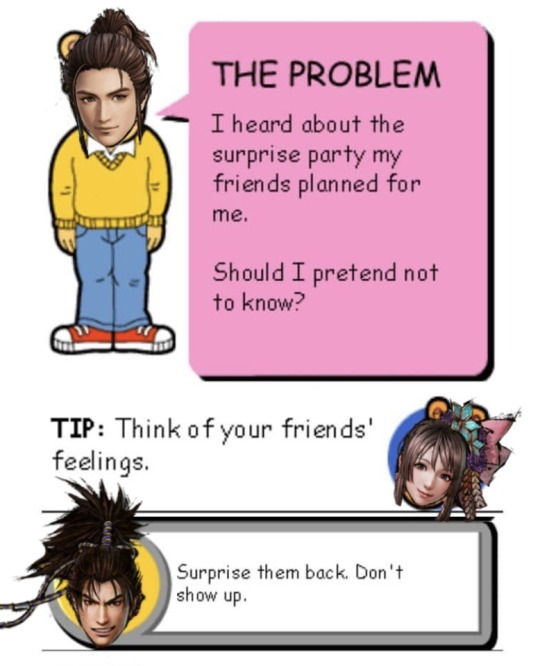

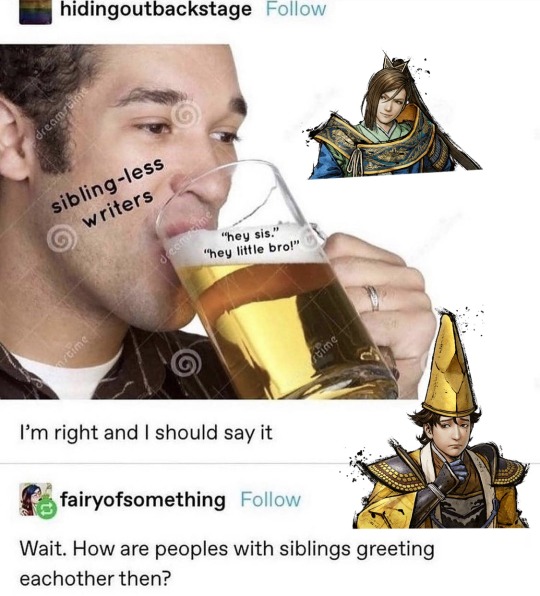
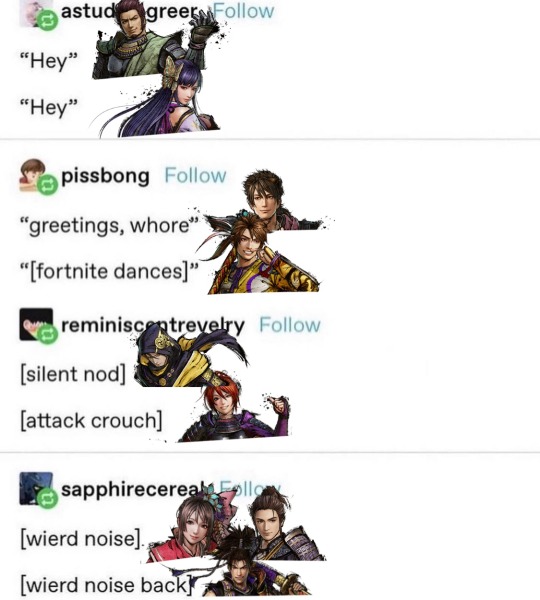
#unnamed friend.jpg#ik for the last one theyre not all siblings i just had to pick close friends lmao#this is so dumb#samurai warriors#samurai warriors 5#text post meme#aw shit i gotta tag ppl now#toyotomi hideyoshi#mitsuki#momochi sandayu#kobayakawa takakage#oda nobunaga#oda nobuyuki#mori motonari#nakamura kazuuji#saito yoshitatsu#nohime#oichi#ashikaga yoshiaki#asakura yoshikage
72 notes
·
View notes
Photo

Well, at least they’re portraying this as a misinformation and not actually fact. I’m still seeing many people in the English speaking circles bringing up this skull sake cup story as though as it’s fact even in this year of the Lord 2021, when it’s not a clear-cut fact, so I suppose this bears repeating for the umpteenth time.
The story of the golden skulls being sake cups was “written in an ancient document”, but it doesn’t make it fact.
The Shinchoukouki, the earlier of the accounts, writes that the skulls were plated in gold, and displayed during a drinking party. The Azai Sandaiki, that says “the skulls were used as cups”, were written and published decades after. It’s understandable that the information could’ve been distorted through what is the equivalent of a game of telephone.
Edit (4 May 2023): This is thoroughly debunked, because even the Azai Sandaiki does not mention any skull cups at all. Far as I can tell, this is actually wholesale fiction.
Why the skulls needed to be plated in gold is not recorded explicitly, but Professor Miyamoto Yoshimi thought that it was done in accordance to the samurai tradition of “head presentation”. Samurai in the medieval times have a tradition to present and display the severed heads of the enemy generals. It’s in fact a samurai’s wife’s duty to clean up the heads and decorate them to make it beautiful for presentation.
The practice seems to have dwindled a bit during Nobunaga’s time, but it doesn’t mean that the practice have ceased completely. There was a letter Nobunaga’s son had written, that described that Asakura’s head was to be presented to the shogun first. The presentation Nobunaga did with his own vassals happens a few months after that.
Some sites/articles/blogs parade around this picture of the golden skull cups. These? These are movie props. It’s not real, and is never meant to be understood as “real”. This is not “proof” that the skull cups story is true.

You can even watch the movie with this very same props here: https://www.youtube.com/watch?v=6Qr9WreQHPs
#slbp#samurai love ballad party#nobu route#oda nobunaga#Azai Nagamasa#Asakura Yoshikage#commentary#SEQUEL ROUTE
22 notes
·
View notes
Photo

*sighs*
4 notes
·
View notes
Photo



Yoshikage’s introduction scene basically translates to ‘Look at me I’M FABULOUS~’. I didn’t like him much in Nagamasa’s route since he seemed pretty useless, but his side story earned him some points. At least he died with dignity.

#asakura yoshikage#hana oboro#otome game#otomate#spoilers#hanaoboro spoilers#ryo plays hanaoboro#hanaoboro
12 notes
·
View notes
Text
Top 15 Anime Villains of All Time
1. Griffith
2. The Major
3. Shinobu Sensui
4. Light Yagami
5. Johan Liebert
6. Yoshikage Kira
7. Donquixote Doflamingo
8. Meruem (Hunter x Hunter)
9. Vicious (Cowboy Bebop)
10. Younger Toguro
11. Dio Brando
12. Hao Asakura (Shaman King - Don’t even argue with me lmao)
13. Shishio Makoto
14. Frieza
15. King Bradley/Father (Full Metal Alchemist)
Honorable Mentions:Funny Valentine, King Piccolo, Madara Uchiha, Orochimaru, Raoh, Medusa (Soul Eater), Ragyō Kiryūin, Gilgamesh, Hisoka, Chrollo Lucifer, Alexander Anderson,Pain, Vegeta, Homunculus/Greed
lol how bout you guys what’s your top 10 or 15? or if y’all don’t agree that’s iight but just know you’re wrong lmao
#this is my opinion#i could probably do a top 50 but naw#doflamingo#griffith#the major#vicious#dio brando#mypost#hao asakura#toguro#frieza#yoshikage kira#meruem#shishio makoto#textz#list
94 notes
·
View notes
Text
🌸 HISTORICAL NOTES - Akechi Mitsuhide(1528-1582)
As a disclaimer we do not know a lot about him and there is a lot of uncertainty when it comes to him,with that out of the way,i hope you enjoy my post.
He is said to have had been born in 1528(second the Akechi Gunki) and his parents are believed to be Akechi Mitsutsuna and a daughter of the Wakasa branch of the Takeda clan. His father died on the year 1538,leaving Mitsuhide under the guardianship of his uncle,Akechi Mitsuyasu.
In 1556; Saitō Yoshitatsu led a rebellion against his father and Mitsuhide's uncle,Saitō Dōsan. Mitsuhide supported Dōsan,however Dōsan lost and it led to Akechi Castle being attacked by Yoshitatsu. There are theories that say that Mitsuhide served Asakura Yoshikage for some time but i'm not so sure on how accurate those claims are.
Due to the Eiroku incident,that led to the murder of the shōgun Ashikaga Yoshiteru,his brother Ashikaga Yoshiaki fled to Wakasa province and got in contact with many powerful daimyō for support and particularly,Oda Nobunaga. Oda Nobunaga's invasion of Minō province caused Yoshiaki to lose his trust on him and for him to enter in contact with Asakura Yoshikage and led to him pleading with Yoshikage for him to march on the capital and get him proclaimed shōgun and this in turn led to Yoshiaki and Mitsuhide to get in contact. Mitsuhide was said to have persuaded Yoshiaki to not rely on Yoshikage and to instead search for Oda Nobunaga's support after Yoshiaki's pleas for Yoshikage to march upon Kyoto went ignored. Due to Sagiyama-Dono(Nōhime or Saitō Kichō/Kochō,Saitō Dōsan’s daughter and Mitsuhide’s cousin on her maternal side) being Oda Nobunaga’s legal wife,it was easy for him to get into contact with Nobunaga.
With the agreement between Yoshiaki and Nobunaga settled,Mitsuhide joined service under the Oda clan. He joined the march to Kyoto and in 1569,defended Yoshiaki from a attack. At a point,started to work with Hashiba Hideyoshi,Niwa Nagahide and Nagakawa Shigemasa to serve as magistrates on Kyoto.
He split from Yoshiaki on 1573,and continued to serve Oda Nobunaga throught his campaigns. Now I’m sorry but doing research on everything he did is kinda overwhelming but just keep in mind he was a great player among the Oda forces and served in many of Oda’s battles and campaigns.
In 1581,Mitsuhide became extremely depressed after the death of his younger sister,Tsumaki(who was said to have been one of Oda’s consorts). This was said to have had contributed to Mitsuhide’s betrayal of Oda the following year.
In 1582,after receiving orders from Oda to support Hashiba Hideyoshi during his campaign against the Mōri,he informed his senior retainers of his intention to betray Nobunaga.
The following month after this,Mitsuhide launched a attack on Honnō-ji Temple that caused Nobunaga’s death by Seppuku and Oda Nobutada,Nobunaga’s oldest son and heir,was surrounded at Nijō castle by the Akechi clan’s forces and died there. Hideyoshi,unlike Mitsuhide’s prediction,quickly signed a peace treaty with the Mōri and rushed to fill the power vacuum. Mitsuhide struggled to keep the support of his troops and his forces of 13,000 soldiers dwindled to 10,000.
Hideyoshi,who had joint forces with both Niwa Nagahide and Ikeda Tsuneoki,was quick to attack him at the battle of Yamazaki with his forces of 20,000 soldiers. It is unknown how Mitsuhide died,but he was said to have had died at the hands of a bandit who attacked him while he fled after his loss at the battle in July 2 of 1582.
#❪🌸❫ Achilles’s notes#I actually am very proud of this!#I personally really like Mitsuhide and i find it fun to make my first post about him and my notes on him
8 notes
·
View notes
Text
The Nobunaga skull cups story debunked, again
A good while ago, I posted a debunking of the story that said Azai and Asakura’s skulls were turned into sake cups. I claimed that the origin of this narrative is actually the Azai Sandaiki, and this is all dubious because it’s a text that is at best considered more of a compilation of “folklore” rather than a legitimate chronicle.
Well, as it were, the Japanese government has a digitization of "Collection of Historical Texts” 史籍集覧 compiled by one Kondou Heijou 近藤瓶城. Volume 6′s index says that it contains the whole compilation of Azai Sandaiki, so I decided to have a look at it myself to see if the skull cup story is indeed from there.
It was not.
The Azai Sandaiki text actually literally just says the exact same thing as the Shinchoukouki. The segment I marked in red says “Nagamasa and Yoshikage’s heads were stripped of flesh and lacquered” (hence, skulls), and the segment I marked in blue says “[the skulls] were presented alongside the sake cups during New Year celebrations with the daimyou at Azuchi”. There’s nothing about the skulls actually being the cups.
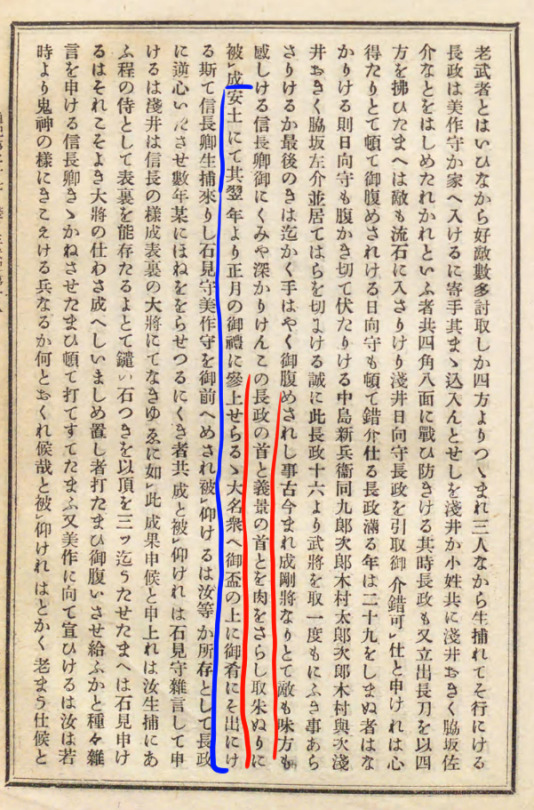
I did another search online to see if anyone managed to identify other references, but as it turns out, the articles that made the claims mostly links to Wikipedia with a time stamp of 2021. That claim about the Azai Sandaiki has since been removed in the live page (probably by people who double-checked the same book). The text now simply says that the skull cups story is a myth, and cites no origin of the myth.
That means Shiba Ryoutarou’s Koumyou ga Tsuji novel is now the sole oldest identifiable source of this skull sake cup story. If there is no older chronicle or historical text that Shiba copied from, then this is all just wholesale fiction.
It’s possible that the archaic phrasing might have caused Shiba to misunderstand what was going on here. Or perhaps, he purposely twisted the original historical text to fit his novel’s narrative. There’s nothing wrong in him taking artistic liberties, of course, since he’s just writing a novel. The fault lies in the people who then paraded around this narrative as historical fact.
If Shiba Ryutarou made it up for his novel, then the whole narrative about skull cups is all garbage, and has not even a shred of historical value (Edo period folktales at least has some possibility being true, we just don’t always know for sure)
#oda nobunaga#Azai Nagamasa#Asakura Yoshikage#Sengoku Fake News#azai sandai#Azai Hisamasa#sengoku#sengoku era#sengoku jidai#sengoku period#japanese history#research
28 notes
·
View notes
Text
Shout-Out to Fuwa Mitsuharu
Now, right from the start I know what you are asking. You are asking “Who in the hell is Fuwa Mitsuharu?” and you are not alone. That is why I want to take a minute to talk about one of the best samurai you’ve never heard of. Good luck even finding information about him on a wiki page or seeing him in any anime or video game. If Nobunaga’s army was a corporate office image Fuwa Mitsuharu as the mid-level employee no one ever thinks about or remember but who still did everything necessary to get things done and moving forward. He was a samurai that served Nobunaga. Did almost nothing super epic or special. He just did his job, and lived his life, and died of illness/old age. He’s almost never going to be a major video game character and is likely never talked about. Mitsuharu served as the lord of Nishinoho Castle in Mino Province and, from early on as a retainer of the Saitō clan of Mino. Along with Inaba Yoshimichi, Andō Morinari, and Ujiie Naomoto, Mitsuharu was known as one of the Western Mino Group of Four. He was extremely loyal to the Saito clan and while he was more a fan of Dosan than his son, Mitsuhara still stuck around until Mino had been completely conquered by the Oda. At that point he accepted Nobunaga as his new lord. In the seventh month of 1568, after Nobunaga responded to pleas from Ashikaga Yoshiaki (who was under the protection of Asakura Yoshikage of Echizen) to march upon Kyōto, Mitsuharu, together with Wada Koremasa, Matsui Sadakatsu, and Shimada Hidemitsu, headed toward Echizen to meet Yoshiaki. After capturing Kōhoku in the battle for the capital, Mitsuharu was sent to meet Yoshiaki who was waiting at the Ryūshō Temple. Thereafter, Mitsuharu participated in the Siege of Ōkawachi Castle in the eighth month of 1569, an attack on Odani Castle in the sixth month of 1570, the Shiga Campaign in the ninth month of 1570, an offensive in Ise-Nagashima in the ninth month of 1571, an encirclement of enemy forces at Katano Castle in the fourth month of 1572, the Siege of Makishima Castle in the seventh month of 1573, and the Siege of Ichijōdani Castle in the eighth month of 1573. In 1574, after the killing of Maeba Yoshitsugu of Echizen, Mitsuharu deployed with Hashiba Hideyoshi and Niwa Nagahide to Tsuruga and, in the sixth month of 1574, participated in a subsequent offensive in Ise-Nagashima. In the eighth month of 1575, Mitsuharu participated in the Echizen Ikkō-ikki. After this campaign, Oda Nobunaga awarded Shibata Katsuie control of eight districts in Echizen. Together with Sassa Narimasa and Maeda Toshiie, Mitsuharu governed two districts in Fuchū in Echizen while also serving as metsuke, or overseers, for Katsuie. These three individuals were referred to as the Fuchū Group of Three. Mitsuharu resided in Ryūmonji Castle in Echizen. Owing to ongoing battles against the Kaga Ikkō-ikki and Uesugi Kenshin, their service as yoriki, or security forces, for Katsuie, became increasingly notable. In the eighth month of 1577, each one of the Fuchū Group of Three joined in a battle to pacify ikki forces in Kaga under Katsuie as their commander-in-chief. In the second month of 1581, Mitsuharu joined Toshiie and others in the Kyōto Mounted Horse Parade as one of the bushō in the Echizen group led by Katsuie, but reports arrived that Uesugi Kagekatsu had invaded Etchū Province and surrounded Koide Castle, so those from the Echizen group under the command of Katsuie were ordered to deploy.Nevertheless, Mitsuharu was not entirely wed to the command of Shibata Katsuie, mobilizing for the Saika Offensive from the second month of 1577, the Siege of Arioka Castle from the eleventh month of 1578, a deployment to Etchū and Kaga on 3/15 of 1581, and the Iga Offensive in the ninth month.Mitsuharu died in Echizen Province, but there are various theories concerning the date, including 12/14 of 1580, 11/8 of 1581, after 1581, or around 1583. Mitsuharu was succeeded by his son, Fuwa Naomitsu. (Thank you to https://sengokujidai.org/ who wrote all this out and phrased it better than I was willing to take time to write this evening) So there you go Fuwa Mitsuharu. You can say thank you to me in a dream if you want. You did your job, didn't cause bullshit, and died. Which is still better than most people of your era. Well done my guy. Well done man. You deserve more credit in media than you get. But you now have a permanent place on this blog and on tumblr.
15 notes
·
View notes
Text
My personal SW5 impressions of characters after playing the game once (plus some lol)
note: I’m talking about all of them as characters in a video game.
----
Nobunaga - ngl I love him. I feel his depiction might become a bit controversial among fans, but as a story it’s great imho.
Mitsuhide - I love him too lol deep down he’s pretty similar to his SW4 counterpart, but he also isn’t. He made different choices, and there are different settings (i.e. Akechi castle being burned down and his whole family dying) that made a difference, and then there’s his relationship with Nobunaga [but it isn’t just Nobunaga who influences Mitsuhide]
Hideyoshi - he’s such a fun character. It’s always a hit or miss with Hideyoshi and me in various media, and I admit i wasn’t a big fan of some parts of SW4 Hideyoshi, but this younger version who is all about making it big and becoming a powerful daimyou is refreshing and fun. There’s some rivalry between him and Mitsuhide (mostly one-sided), and respect for Ieyasu. The Hashiba group (Hideyoshi, Hanbei, Kazuuji, Kanbei) are very warm and almost family-like
Ieyasu - he’s also a nice character. I liked SW4 Ieyasu and the Tokugawa clan a lot, and you can still feel the bonds here as well. He’s very, not serious, but he knows he’s not good enough and he works really hard to become a good samurai. He’s very loyal to Nobunaga, and he’s like a puppy around him. It’s cute.
Imagawa Yoshimoto - he’s pretty much there only to be a villain
Shingen - I was never particularly interested in Shingen (and Takeda clan and Sanada clan as a whole in SW4) so having Shingen as the enemy officer only is like shrug (he’s fun in the Uesugi vs Takeda stage in Mitsuhide’s chapter, but his presence isn’t strong overall, I know there’s one Ieyasu stage where Takeda are with them but I forgot what it’s about)
Kenshin - LOL this time Kenshin got some Kanetsugu’s characterization so he’s very loud, very opinionated, and all about righteousness, which isn’t GI this time but TADASHIKI. At the moment, he’s a bit annoying (but I also felt that way about SW4 Kanetsugu at the beginning, and he’s among my faves now, so...)
Mouri Motonari - he’s also there to be a villain and he does it well. He’s not a nice grandfather, he’s dark and shrewd, and it’s very different from SW4.
Azai Nagamasa - he’s different, I’m still not sure if in a good or bad way
Matsunaga Hisahide - he’s fun lol (I mean I liked his SW4 version, and I like his SW5′s one too) He’s not really a joke character anymore, and he’s VERY interested in Mitsuhide. I’m glad he stayed as a playable character.
Nouhime - (no one calls her Nouhime lol ETA: Sena does) she is a great character but unfortunately her ‘screen time’ is way too short. Her interactions are mostly limited to Nobunaga, but I guess I just need to trigger more in battle dialogues. I like what they did with her in the IF stories.
Mitsuki - she was such a delightful surprise. She’s written well, and I really like her story, and also her involvement in Nobunaga and Mitsuhide’s story
Toshiie - he’s pretty much the same as in SW4, he’s Nobunaga’s childhood friend and just follows whatever Nobunaga orders, without questioning it much (the furthest he went was before Hiei-zan, but nothing really came from it anyway). He has bigger role during the early chapters, after Mitsuhide joins Nobunaga, Nobunaga apparently forgets he already had a BFF? idk lol
Katsuie - he became more handsome, but at the core, he’s pretty much the same Katsuie too. But this time they decided to make Katsuie loyal primarily to Oichi and make him her bodyguard (probably to avoid any potential creepiness considering Oichi’s age this time). Toshiie and Katsuie don’t really have any familial relationship, and Hideyoshi calls him “danna” lol
Oichi - she’s a... child, basically (and I did like the mother-like figure in SW4, especially in SW4-2), but she keeps growing on me.
Saitou Toshimitsu - he’s extremely loyal to Mitsuhide and he follows him no matter what. They have a nice lord/vassal relationship very different from all lord/vassal relationships that were in SW4, so it’s refreshing
Yamanaka Shikanosuke - he’s a great character, he’s friends with Mitsuhide, and they both swore under the moon to become stronger, so they could protect those who were important to them, and that promise made them move forward. It’s a great friendship, but tragic. (as everything in this stupid game is) Although, I admit that at this time, more than his relationship with Mitsuhide, I’m more interested in his relationship with Mori Motonari and Kobayakawa Takakage.
Hanbei - omg I love this version of Hanbei a LOT. I feel like in SW4 he wasn’t around that much, and when he was I just focused more on Kanbei, but do I love him in SW5. His characterization is basically the same, but he’s also more soft? And more on equal ground with Hideyoshi, whom he calls ‘Hideyoshi’, and while their relationship isn’t THAT different, Hideyoshi’s personality and age makes it different, and I love it. Because of his time with Dosan, he gets a lot of ‘screen time’ this time around, so that’s great too.
Kanbei - Kanbei is... young LOL He appears pretty late in the game, so I didn’t have much time to really focus on him because this time, I focused more on Hanbei. Their senpai-kohai relationship is cute though
Nakamura Kazuuji - he’s... there. He has a nice relationship with Mitsuki, but we also never really see them interact properly or hear about their past (maybe the citadel events?), and he’s very loyal to Hideyoshi, so that’s cool too. Like I said above I like the Hashiba group.
Sena - Sena is great, different from the other girls in this game, more mature.
Tadakatsu - he’s like a big loud puppy who follows his master Takechiyo. I didn’t focus on him much tbh I’ve always preferred Ieyasu’s relationship with Hanzou, and that didn’t really change. And this time there was also Sena, so... Tadakatsu was... just there, more like an older brother than a vassal
Hanzou - also great. The age difference this time made some changes with his relationship with Ieyasu, and there’s no ‘shadow to Ieyasu’s light’ symbolism this time, but it is still a nice relationship.
Sandayu - he’s a character that’s very present and he goes from a nice big brother figure to ********, but I haven’t really made an opinion about him yet. He’s a good character, but I like others more, basically.
Kobayakawa Takakage - hahahahaha he’s very self-centered and at first I was like you’re so annoying, but he also started to grow on me, so we’ll see (I definitely do prefer SW4 though). Although, this Kobayakawa and this Hanbei would work quite well together. I need to replay the Hashiba VS Mouri stages.
Saika Magoichi - he’s a nicer version of his SW4 version with no weird womanizer thing thrown in (yet). Unfortunately he only serves as a villain and you don’t really get to know his story, but he’s a person with integrity
Yasuke - Yasuke only joins at the very end of the game, and he’s very cool. He definitely works better than Ranmaru for what this story is about.
Oda Nobuyuki - he was a nice character. tbh they could have made him fully playable because he was present for two whole chapters but well...
Okabe - idk you fight against him
Katsuyori - I like that Shingen calls him ‘Jirou’ LOL otherwise it didn’t really matter to me if he had a special design or not (but like I said I’m not interested in Takeda clan) - he’s voiced by the same guy who’s voicing Kobayakawa so when I don’t particularly pay attention I’m like why is Ieyasu fighting Kobayakawa? lol
Kikkawa Motoharu - ??? he’s there. he’s the muscles to Kobayakawa’s brain, I guess
Mouri Terumoto - he’s young, he feels the burden, but he doesn’t have much presence
Dousan - well, Dousan is Dousan
Saitou Yoshitatsu - at one moment he’s laughing like a cartoon villain
Asakura Yoshikage - he’s so good. He has a bigger presence that Nagamasa, and it’s a shame he wasn’t made fully playable. But he also never joined Nobunaga... he’s a really nice lord who cares about his territory and people, and does everything to protect them
Ashikaga Yoshiaki - your usual incompetent shogun, I guess
Mitsubushi Fujihide - I love him! He’s very loyal to the shogunate and Yoshiaki and does everything to protect him. (even though the shogun is the way he is)
aaaand done. Future me, how did your opinions change?
TOP 5 characters: Mitsuhide, Nobunaga, Hanbei, Hideyoshi, Toshimitsu
3 notes
·
View notes
Text
New Years in the Shincho-koki:
On the first day of the First Month [of 1574], everybody who was anybody in Kyoto and its neighboring provinces presented himself before Nobunaga in Gifu. They were all invited to participate in a toast according to the sangon ceremony. After the outsiders (takokushū) had retired and only Nobunaga’s horse guards were left, Some novel, as yet unheard-of appetizers were served at a second banquet: The head of Asakura Sakyō no Daibu Yoshikage, The head of Azai Shimotsuke [Nagamasa’s father], and The head of Azai Bizen [Nagamasa]. These had been taken by Nobunaga the previous year in the North. The banquet began when the aforesaid three skulls, lacquered and gilt, were brought out on white wooden dinner trays as a relish to the saké. The men made merry, reciting lines from plays and disporting themselves in general. Nobunaga was in unbounded, limitless high spirits. He was exhilarated.
Nobunaga showed everyone his private quarters [in the newly-built Azuchi castle in 1578], where he had commissioned Kano Eitoku to paint famous scenes from the Three Countries in polychrome. It was beyond the capacity of the mind to comprehend or words to describe the multitude of masterpieces that Nobunaga had assembled. Indeed, his power and his glory were beyond measure. Nobunaga invited everyone into these chambers and treated them all to New Year’s soup (zōni) and assorted continental sweetmeats. It was the memory of a lifetime for these men, an experience to be related for generations to come. Words could not describe their gratitude.
On the 5th of the First Month [in 1579], Kuki Uma no Jō came up from the port of Sakai to Mount Azuchi to wish Nobunaga well at the start of the New Year. Nobunaga graciously granted him leave, saying that he ought to use the current lull in the fighting to go home, see his wife and children, and then come back to the central provinces in due time. Kuki went down to Ise Province with a feeling of gratification.
[In 1580,] on the first day of the First Month, it snowed all day. Taking into account that his men had all been exerting themselves to their utmost on frontline duty in Settsu Province these past few years, Nobunaga sent round an official notice this winter relieving them of the obligation of ceremonial attendance at the start of the New Year. So they did not present themselves before him.
[In 1581,] Nobunaga ordered a riding ground to be constructed along the lakeside, to the north of the fortifications of Azuchi and west of the Matsubara ward. On New Year’s Day, work commenced under the supervision of Suganoya Kuemon, Hori Kyūtarō, and Hasegawa Take. On the 2nd of the First Month, Nobunaga gave the townspeople of Azuchi, ward by ward, a large number of wild geese and cranes caught by his falcons. To express their gratitude, the townspeople gave a celebratory Noh performance at the Sasaki Shrine. Then they reverenced his gifts before accepting them.
7 notes
·
View notes
Text

https://youtu.be/KLilzq-n4dA
A coup by Miyoshi and Matsunaga's children broke out, and Shogun Yoshiteru was killed. When the Shogun's seat was vacant, Kyoto was divided into two groups: the support group for his younger brother, Kakukei, and the support group for Yoshihide. Matsunaga and Fujitaka help Kakukei, whose life is targeted by Miyoshi, escape from Yamato and hide himself. On the other hand, Mitsuhide, who learned of Yoshiteru's death, went to Matsunaga and vigorously denounced the assassination of Yoshiteru. Matsunaga shows Mitsuhide the letter he received from Yoshikage Asakura. Mitsuhide confirmed that the Asakura house was prepared to harbor Kakukei as a vessel of the Shogun. Mitsuhide is unimpressed, and moves away from Matsunaga, blasting him for deceiving Echizen.
Kirin ga Kuru episode 24 preview
8 notes
·
View notes
Video
youtube
[English subtitled video] The graveyard of Yoshikage Asakura, a Japanese military commander in Warring States Period, is located in an urban area within walking distance of Ono Castle. Yoshikage was the last head of Asakura clan, one of territorial lords in Warring States Period. He was defeated in the battle against Nobunaga Oda, and he died here in Ono City. The graveyard that is located in a residential district and now its quiet surroundings are a park with spring water and a pond.(1'01") この動画は、昨年の夏、朝倉義景の墓所を訪ねたときのものです。NHK大河ドラマ「麒麟がくる」にいよいよ登場した朝倉義景。ユースケ・サンタマリアさん演じる義景を見て、思っていたイメージと違った反面、無性に興味が湧いてきました。実際の義景の人間性はどうだったのでしょうか。一方、明智光秀の越前での当時の評価はとても高かったようですね。ところで朝倉義景の墓は、大野城から徒歩圏内の市街地にあることをご存じですか。義景は朝倉氏最後の当主でしたが、織田信長との戦いに敗れ、大野で最期を遂げました。静かな墓所にある湧水は「義景清水」と呼ばれています。一乗谷朝倉氏遺跡も再開されて、この義景の墓所もこれから訪れる人が増えそうですね。(1'01")
#Japan#Fukui#Ono#Asakura#military commanders#warring states era#graveyard#oda nobunaga#placetovisit#historical sites#park#springwater
9 notes
·
View notes